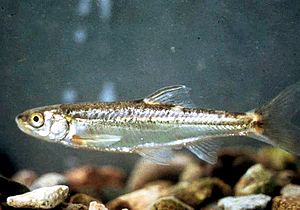Spikedace facts for kids
Quick facts for kids Spikedace |
|
|---|---|
 |
|
| Spikedace, Meda fulgida | |
| Conservation status | |
| Scientific classification | |
| Genus: |
Meda
|
| Species: |
fulgida
|
The spikedace (Meda fulgida) is a special type of fish. It's a ray-finned fish, which means its fins are supported by bony rays. This fish belongs to the minnow family, called Cyprinidae.
The spikedace is an endangered species. This means there are not many left in the wild. You can find spikedace in rivers and streams in Arizona and New Mexico, in the United States. They love to live in water that moves quickly.
Contents
What Does a Spikedace Look Like?
The spikedace is a small fish. It usually grows to be about 7.5 centimeters (about 3 inches) long. That's shorter than a typical pencil!
It has a thin body. The front part is a bit flat, and its tail section is very flat. It has a pointy nose and a mouth that is slightly underneath its head. Its eyes are quite large.
The fin on its back, called the dorsal fin, starts behind its belly fins. The first ray, or support, in its dorsal fin is strong and sharp. It usually has seven rays in its dorsal fin and nine rays in its anal fin (the fin near its tail underneath).
The spikedace's skin is olive-gray to light brown on top. Its sides are a shiny silver, sometimes with blue colors. It also has black spots on its back and upper sides. When male spikedace are ready to breed, their heads and fins turn a bright, shiny yellow!
Where Does the Spikedace Live?
Long ago, the spikedace was common. You could find many of them in the upper Gila River basin. This area is in both Arizona and New Mexico.
In Arizona, they lived in rivers like the Agua Fria, San Pedro, and San Francisco. They also lived in the Gila, Salt, and Verde Rivers. In New Mexico, they were in the San Francisco River and the Gila River.
Today, you can still find spikedace in a few places. In Arizona, they live in Aravaipa Creek and Eagle Creek. They are also in the upper Verde River system. In New Mexico, they are found in the upper Gila River system.
Its Home Environment
Spikedace like to live in the middle of the water. They prefer areas where the water moves. They often swim in water less than 1 meter (about 3 feet) deep. They like currents that move at a speed of 0.3 to 0.6 meters per second.
These fish often gather at the downstream ends of rivers. However, some have been found in shallower, faster-moving parts of streams. In bigger rivers, spikedace are usually found near where smaller creeks join the main river.
How Many Spikedace Are Left?
The spikedace used to be found all over the Gila basin. But in the last few decades, their numbers have gone down a lot. Even in places where they still live, there seem to be fewer of them now.
The number of spikedace can change a lot. Sometimes their population goes down, and sometimes it grows quickly. Experts are still studying where they live and how many there are.
Protecting the Spikedace
Many things can harm the spikedace. These include:
- Taking too much water from their homes.
- Building dams on rivers.
- Changing river channels.
- Cows and other livestock grazing near streams.
- Cutting down trees.
- Mining and building roads.
- Polluting the water.
- Putting non-native fish into their habitats.
Other big threats are less water in streams and changes to their homes. Also, non-native animals like crayfish can compete with them for food. Non-native fish, especially the red shiner, can eat spikedace or compete with them. Protecting their homes is very important to help the spikedace survive.


